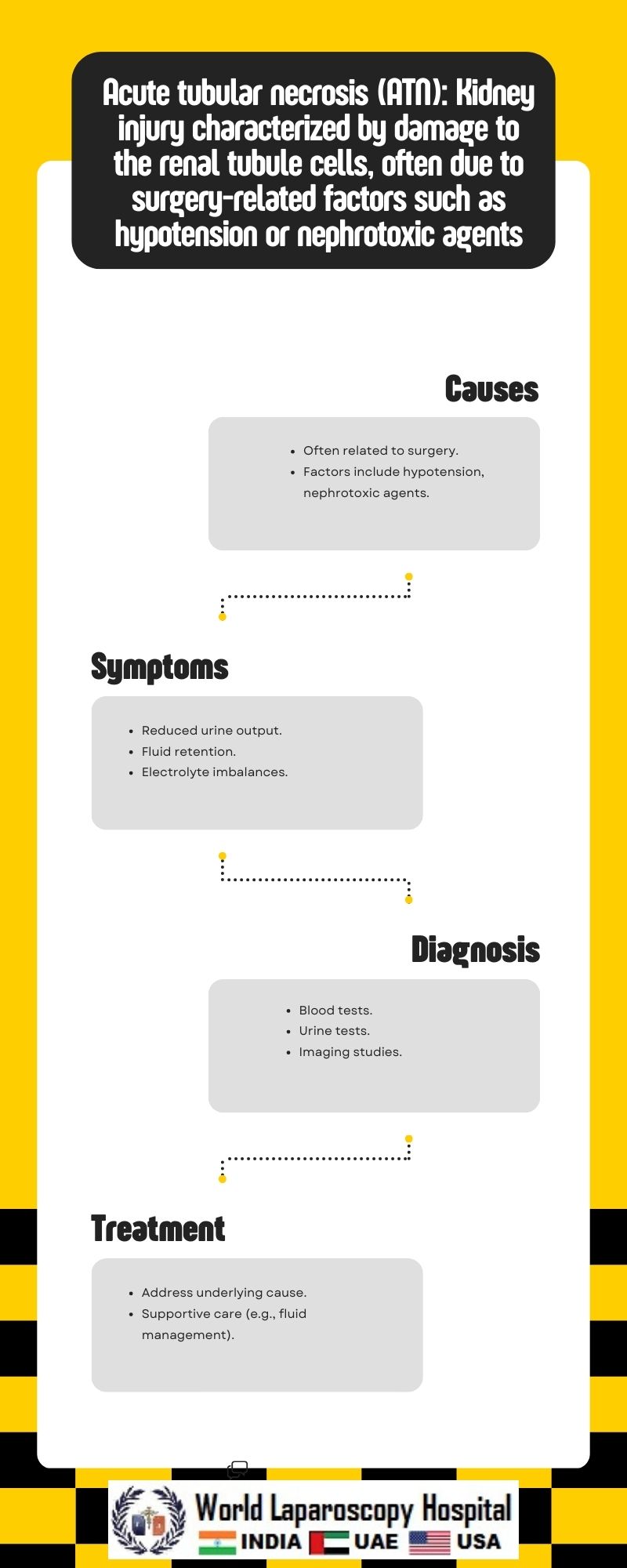Acute tubular necrosis (ATN): Kidney injury characterized by damage to the renal tubule cells, often due to surgery-related factors such as hypotension or nephrotoxic agents
Introduction
Acute Tubular Necrosis (ATN) is a severe form of acute kidney injury (AKI) characterized by damage to the renal tubule cells, leading to impaired kidney function. It is a common condition seen in hospitalized patients, especially those in intensive care units (ICUs), and can be caused by a variety of factors, including hypotension, nephrotoxic agents, and sepsis. Understanding the pathophysiology, causes, diagnosis, and management of ATN is crucial for healthcare professionals to provide optimal care for affected patients.

Pathophysiology of Acute Tubular Necrosis
The pathophysiology of ATN involves several key mechanisms that lead to the damage and necrosis of renal tubule cells. Ischemic ATN, which is caused by decreased blood flow to the kidneys, is the most common form and often occurs in the setting of hypotension or shock. In ischemic ATN, the renal tubule cells are deprived of oxygen and nutrients, leading to cell injury and death.
Another form of ATN is nephrotoxic ATN, which is caused by exposure to nephrotoxic agents such as certain medications (e.g., aminoglycoside antibiotics, contrast agents), heavy metals, and myoglobin released from damaged muscle tissue. These agents can directly damage the renal tubule cells, leading to necrosis.
The initial insult in ATN triggers a series of events, including inflammation, oxidative stress, and the release of pro-inflammatory cytokines, which further contribute to renal tubule cell injury. The damaged tubule cells undergo necrosis, leading to the formation of casts within the tubules, which further impairs kidney function.
Causes of Acute Tubular Necrosis ATN can be caused by various factors, including:
- Hypotension or shock: Decreased blood flow to the kidneys can lead to ischemic ATN.
- Nephrotoxic agents: Exposure to certain medications, heavy metals, or toxins can cause nephrotoxic ATN.
- Sepsis: Severe infections can lead to septic shock, which can cause ATN.
- Surgery-related factors: Certain surgical procedures, especially those involving major blood loss or the use of nephrotoxic agents, can increase the risk of ATN.
- Other medical conditions: Conditions such as heart failure, liver failure, and severe burns can also increase the risk of ATN.
Diagnosis of Acute Tubular Necrosis
The diagnosis of ATN is based on a combination of clinical findings, laboratory tests, and imaging studies. Patients with ATN often present with acute kidney injury, characterized by a rapid increase in serum creatinine and a decrease in urine output. Other common findings include electrolyte imbalances (e.g., hyperkalemia, metabolic acidosis), fluid overload, and uremia.
Laboratory tests such as blood urea nitrogen (BUN) and creatinine levels are used to assess kidney function. Imaging studies such as ultrasound or CT scans may be performed to evaluate the kidneys for signs of obstruction or other abnormalities.
Management of Acute Tubular
Necrosis The management of ATN involves identifying and addressing the underlying cause, providing supportive care, and preventing complications. The key principles of management include:
- Fluid management: Maintaining adequate hydration is crucial to prevent further kidney damage and promote renal recovery. However, fluid overload should be avoided, as it can exacerbate kidney injury.
- Electrolyte management: Monitoring and correcting electrolyte imbalances, especially hyperkalemia, is important to prevent cardiac arrhythmias and other complications.
- Avoiding nephrotoxic agents: Identifying and avoiding medications and toxins that can worsen kidney injury is essential.
- Dialysis: In severe cases of ATN, especially those associated with significant fluid overload or electrolyte imbalances, dialysis may be necessary to remove waste products and excess fluid from the body.
- Monitoring and follow-up: Regular monitoring of kidney function and electrolyte levels is important to assess the response to treatment and prevent complications.
Conclusion
Acute Tubular Necrosis (ATN) is a serious condition characterized by damage to the renal tubule cells, leading to impaired kidney function. It is commonly seen in hospitalized patients, especially those in intensive care units, and can be caused by various factors, including hypotension, nephrotoxic agents, and sepsis. Understanding the pathophysiology, causes, diagnosis, and management of ATN is essential for healthcare professionals to provide optimal care for affected patients and prevent complications.